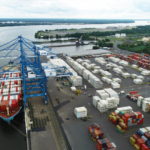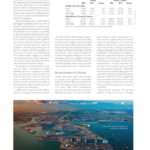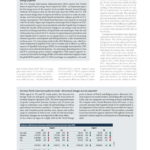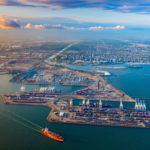The business of the U.S. port industry is currently significantly affected by trade policies and tariff disputes of the Trump administration. However, the ports are primarily looking to the medium to long-term future and the need for a modern infrastructure. By Michael Meyer
By just about anyone’s standard, 2018 was a good year for maritime cargo volume throughput for America’s seaports«, Kurt Nagle[ds_preview], CEO of American Association of Port Authorities (AAPA), tells HANSA. From January to October total U.S. waterborne foreign trade rose by 5.7% to 1.213mill. t, according to data from the U.S. Census Bureau. Remarkably enough, there was quite an imbalance, with exports rising 13.6% to 651,000 t and imports declining 2.2% to 562,100 t. In terms of the value of these trades, there was a growth of 11.1% to 1.470mill. $, with 486 mill. $ exports (+13.3%) and 983mill. $ imports (+10%).
For 2018, many U.S. ports announced they were experiencing record or greatly increased cargo volumes, based on a number of factors, including a strong American economy, enhanced demand for American exports, competitive freight rates and a desire by importers and shipping lines to land import cargoes into the U.S. before implementation of higher tariffs.
The American economy saw strong gains in the first nine months of 2018, which helped generate greater demand for goods, particularly U.S. imports.
But there are challenging effects from the national trade policies of President Donald Trump and his administration, too. »One of the key changes, however, particularly for steel and aluminium in the first half of 2018, was that relatively hefty U.S. import tariffs were imposed on these products beginning on March 23«, Nagle adds. On Oct. 1, a 10% tariff increase was imposed on many imported goods, mostly from China, that reduced demand for Chinese imports once the second »tranche« of tariffs was implemented in fall. Another tariff rise potentially is slated for March 1, 2019. The tariffs on steel and aluminium were reportedly made to encourage increased U.S. production of those metals, while the increase in tariffs on Chinese goods were reportedly made to discourage China from stealing U.S. intellectual property.
The AAPA CEO reports »an almost universal prediction by trade industry prognosticators« that the U.S. will likely see lower cargo volumes in 2019 than in 2018. Reasons for that are, amongst others, the uncertainties surrounding the »trade war« and the fact that the growth of 2018 can be largely attributed to pulling import cargoes forward in an effort to avoid tariffs. Shipping organization Bimco presented that argument: »With container imports down in November on both coasts, the effects of full inventories and the result of the ongoing negotiations between China and the US will heavily influence what 2019 will have in store for container ports in the U.S.«, Chief Shipping Analyst Peter Sand stated. Currently 27.49mill. t of U.S. containerized imports are affected by the tariffs which represents 14.2% of total U.S. container imports or 24.7% of those imported on the West Coast.
However, AAPA remains hopeful that some of the initiatives the association is advocating will result in greater supply chain and cost efficiencies, leading to lower transportation costs for exporters and importers, and consequently, lower prices for goods and increased consumer demand. He names industry’s equity solution to Harbor Maintenance Tax (HMT) distributions, removing the intermodal cap on FAST Act INFRA grants for funding port-related infrastructure, increasing allocations for port-related projects in the U.S. Department of Transportation’s annual BUILD infrastructure grants, and increasing staffing and resources for Customs and Border Protection at U.S. seaports.
Notwithstanding that, AAPA believes the biggest challenges for U.S. ports in the near- and mid-term is to improve the transportation infrastructure, on both the landside and waterside. According to the association, seaport activity supports 23 million American jobs and generates 321 bn $ in federal, state and local tax revenue each year. The total value of economic activity related to America’s seaports is 4.6tr $, representing 26% of the U.S. economy. However, freight connections to U.S. ports »are falling behind 21st century needs«, Nagle says, adding »We must prepare the nation’s infrastructure to meet a growing demand for the safe, efficient movement of freight.«
One point of criticism relates to »First and last mile«. One-third of AAPA member ports say congestion at landside connectors has caused productivity to decline by 25% or more over the past 10 years. Nearly 80% of ports in the U.S. require at least 10mill.$ investment in their landside connectors through 2025; 31% require over 100mill. $.
AAPA urges Congress and the Administration to support infrastructure policies that include robust freight transportation provisions and sustainable funding for the nation’s seaports. Recommended action for federal policymakers include the modernization and maintenance of navigation channels through waterside investments. »The Corps of Engineers’ Coastal Navigation Program saw overwhelming bipartisan support through the Water Resources Development Act of 2018, but funding, donor equity, and efficiency challenges remain«, Nagle claims.
Record volumes in California
On the West Coast, main container hubs Los Angeles and Long Beach recorded their highest container volumes ever in 2018. The Port of Los Angeles moved 9,458,749 TEUs, 1.2% more than 2017’s record-breaking year. Top trading partners are China/Hong Kong, Japan, Vietnam, South Korea and Taiwan. »2018 was marked by a robust economy coupled with tariff-induced surges of cargo headed to U.S. retail and manufacturing sectors,« said Executive Director Gene Seroka. »These extraordinary volumes highlight the need for continued stakeholder collaboration on methods to maximize supply chain efficiency. Through a number of initiatives, we are focused on both physical and digital infrastructure enhancements.« For the time after Chinese New Year, the port expects to likely see a tapering off in imports. »Obviously, the discussions currently taking place between the United States and China regarding tariffs and trade will have a significant impact on trade. Like the rest of the world, we are waiting to see how this is resolved«, the port authority emphasizes in response to HANSA.
Long Beach reported, »for the first time in its 108-year history«, a througput of more than 8mill. TEU, as cargo grew more than 7% to set a record for a second consecutive year. The Port – with about 90% of containerized business with East Asia – finished 2018 with 8,091,023 TEUs moved. Imports grew 6.1% to 4,097,377 TEUs, exports totaled 1,523,008 TEUs, up 3.6%; empties increased 11.8% to 2,470,638 TEUs. Harbor Executive Director Mario Cordero tells HANSA: »We expect modest growth in 2019. Tariffs will once again be a factor. So far, we have seen tariffs of about 10%, which businesses seem to be absorbing. If the ultimate level of 25% tariffs are implemented, we could see some negative impacts on trade. The continued uncertainty is problematic for the business environment. I am an optimist. I believe the United States and China will be able to resolve their differences and trade will continue, to the benefit of businesses, workers and citizens on both sides of the Pacific.«
Commission President Tracy Egoscue said earlier, the port has a »monumental« 2019 ahead. »We will be putting the finishing touches on the replacement for the Gerald Desmond Bridge. The new Long Beach Container Terminal is entering its final phase of construction«, she said.
Key projects in the years ahead include 1 bn $ in rail improvements that is supposed to help boost the on-dock rail cargo to 35%, with a long-term goal of 50%. »Rail allows us to move Asia imports to all the major U.S. markets significantly faster than cargo routed through Gulf and East coast ports«, Cordero says. To remain competitive in the future and grow the business, he knows that the port must focus on the »ability to deliver cargo predictably, reliably and fast«. For that, facilities are needed, but in addition, »we’ll also be leveraging information and technology to provide advanced cargo visibility that will allow the supply chain to plan their operations.«
9 % growth in Philadelphia
On the East Coast, the port of Philadelphia saw a record TEU count of 600,000, which was 9% growth. 38% of the container moves were refrigerated, making Philadelphia one of the leading gateways for food and agricultural products in the U.S.
The Tioga Marine Terminal benefited from a new multi-modal ocean service, ARRC, connecting PhilaPort with Russia, Central Asia, and Northern Europe. The management expects to continue to grow towards the goal of 900,000TEU annually and increases in autos and forest products. Unlike some analysts, trade fundamentals are described as »good«. »We expect good will and common sense to prevail, and trade to continue in spite of tensions and tariff talk. Global growth continues, and the US economy is staying strong. Over the past few years we have seen substantial growth, despite the tariffs, and our key commodities like perishables show no signs of stopping.«
The biggest item the port is working on is the imminent completion of the 468mill. $ Delaware River Main Channel Deepening Project. The new depth will allow PhilaPort to handle the 14,500TEU ships able to transit the expanded Panama Canal. The next biggest item is the continuation of the Port Development Plan, a 300mill. $ project to improve the terminals.
Further North, the port authority of New York and New Jersey reported a throughput of 7,179,788TEUs in 2018, surpassing the 7-million-mark for the first time. The cargo growth was bolstered by an 8.2% increase in imported goods including clothing, furniture, electronics and other everyday products over the previous record for imports set in 2017. The Port handled one third of all containers on the East Coast of North America; an increase in market share of 2.8%. In addition to cargo containers, the port also set a new all-time record for cargo handled by rail, moving 645,760 containers by rail, up 13.8% over the previous record set in 2017.
The port authority said, the growth in part can be attributed to the completion in June 2017 of the Bayonne Bridge Navigational Clearance Project, which raised the clearance under the bridge from 151 feet to 215 feet, allowing the world’s largest container ships to pass under it. To enhance the port’s ability to handle the record cargo growth, a major new expansion of the rail network was announced. The opening of the final rail facility will allow the port to advance its strategic five-year goal to handle more than 900,000 rail lifts in 2023, the equivalent of more than 1.5mill. fewer truck trips traveling through the local roads.
Georgia Ports hub Savannah moved 4.35mill. TEU in 2018, another »highest annual volume ever«, and a 7.5% increase over 2017. In February, the U.S. Army Corps of Engineers completed outer harbor dredging, marking the midpoint of the Savannah Harbor Expansion Project. The federal government provided 101.12mill. $ to continue SHEP construction this year, and inner harbor dredging is on track to start this year. The expansion of Gate 8 had been completed, and will increase overall gate capacity by 16%, for a total of 56 lanes. The rail volume (860,000TEU) represented a 19% increase. To handle the additional intermodal volumes, GPA will complete Phase I of the Mason Mega Rail project in October of this year, and Phase II by October 2020.
Michael Meyer























